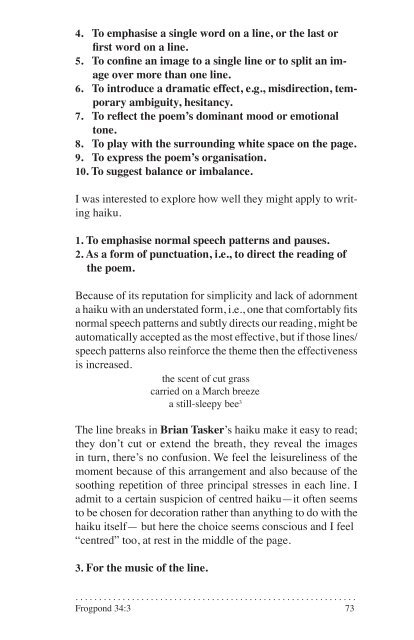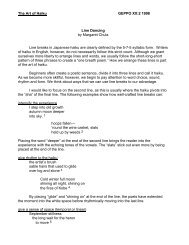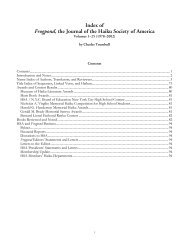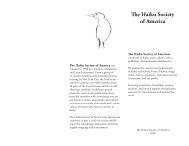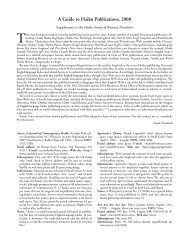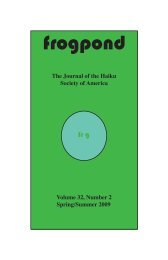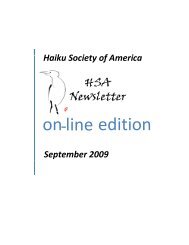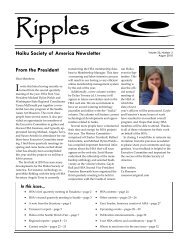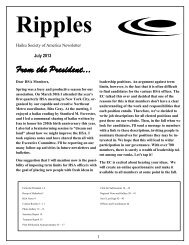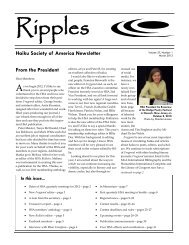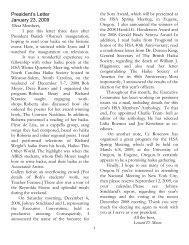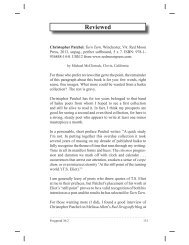Frogpond 34.3 • Autumn 2011 (pdf) - Haiku Society of America
Frogpond 34.3 • Autumn 2011 (pdf) - Haiku Society of America
Frogpond 34.3 • Autumn 2011 (pdf) - Haiku Society of America
You also want an ePaper? Increase the reach of your titles
YUMPU automatically turns print PDFs into web optimized ePapers that Google loves.
4. To emphasise a single word on a line, or the last or<br />
first word on a line.<br />
5. To confine an image to a single line or to split an im-<br />
age over more than one line.<br />
6. To introduce a dramatic effect, e.g., misdirection, tem-<br />
porary ambiguity, hesitancy.<br />
7. To reflect the poem’s dominant mood or emotional<br />
tone.<br />
8. To play with the surrounding white space on the page.<br />
9. To express the poem’s organisation.<br />
10. To suggest balance or imbalance.<br />
I was interested to explore how well they might apply to writing<br />
haiku.<br />
1. To emphasise normal speech patterns and pauses.<br />
2. As a form <strong>of</strong> punctuation, i.e., to direct the reading <strong>of</strong><br />
the poem.<br />
Because <strong>of</strong> its reputation for simplicity and lack <strong>of</strong> adornment<br />
a haiku with an understated form, i.e., one that comfortably fits<br />
normal speech patterns and subtly directs our reading, might be<br />
automatically accepted as the most effective, but if those lines/<br />
speech patterns also reinforce the theme then the effectiveness<br />
is increased.<br />
the scent <strong>of</strong> cut grass<br />
carried on a March breeze<br />
a still-sleepy bee 3<br />
The line breaks in Brian Tasker’s haiku make it easy to read;<br />
they don’t cut or extend the breath, they reveal the images<br />
in turn, there’s no confusion. We feel the leisureliness <strong>of</strong> the<br />
moment because <strong>of</strong> this arrangement and also because <strong>of</strong> the<br />
soothing repetition <strong>of</strong> three principal stresses in each line. I<br />
admit to a certain suspicion <strong>of</strong> centred haiku—it <strong>of</strong>ten seems<br />
to be chosen for decoration rather than anything to do with the<br />
haiku itself— but here the choice seems conscious and I feel<br />
“centred” too, at rest in the middle <strong>of</strong> the page.<br />
3. For the music <strong>of</strong> the line.<br />
. . . . . . . . . . . . . . . . . . . . . . . . . . . . . . . . . . . . . . . . . . . . . . . . . . . . . . . . . . . .<br />
<strong>Frogpond</strong> 34:3 73


